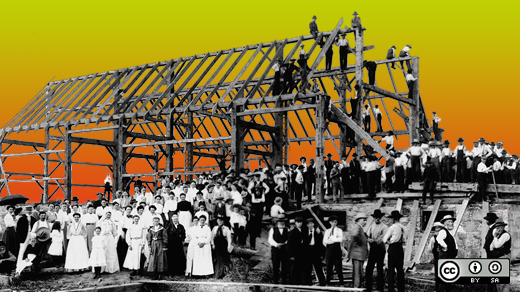Over the past month or so, I've been having a conversation with Iain Gray, Red Hat Vice President of Customer Engagement, about the ways companies engage with communities. I've also written a lot lately about common mistakes folks make in developing corporate community strategies (see my two posts about Tom Sawyer community-building here and here and Chris Brogan's writeup here).
One idea we bounced around for a while was a mashup of community thinking and Maslow's hierarchy of needs. For those of you who slept in with a bad hangover the day you were supposed to learn about Maslow in your intro psych class (damn you, Jagermeister!), here is the Wikipedia summary:
"[Maslow's hierarchy of needs] is often depicted as a pyramid consisting of five levels: the lowest level is associated with physiological needs, while the uppermost level is associated with self-actualization needs, particularly those related to identity and purpose. The higher needs in this hierarchy only come into focus when the lower needs in the pyramid are met. Once an individual has moved upwards to the next level, needs in the lower level will no longer be prioritized. If a lower set of needs is no longer being met, the individual will temporarily re-prioritize those needs by focusing attention on the unfulfilled needs, but will not permanently regress to the lower level."
Now granted, the needs of a company are very different than the needs of a human being. At its very basic level, a company has a "physiological" need to make money. If that need is not being met, little else will matter. But in an ironic twist, this basic need to make money can actually hinder the company's ability to make money if it is not wrapped in a more self-actualized strategy.
To explain what I mean, think about the last annoying salesperson who called or emailed you. Why were you annoyed? Probably because it was very clear to you that the salesperson was badly hiding his basic motivation to make money. He wasn't talking to you because he valued you-- he was talking to your wallet.
Now think about the best recent sales experience you've had. Mostly likely, this salesperson was being motivated by a higher purpose, perhaps something as simple as a desire to make you happy. Sometimes the most effective salespeople aren't even in sales at all-- like a friend who tells you about a new album you should buy, for example. Or sites like Trip Advisor, where you can learn about where to go on vacation from other folks like you.
When it comes to community strategy, most companies have trouble finding motivation beyond the simple need to make money-- and the communities they interact with can tell.
Yet if you look at the greatest companies out there, you'll find that they usually have a strong sense of identity and purpose-- just like Maslow's self-actualized people. Read anything by Jim Collins and you'll see what I mean.
For a recent presentation, Iain developed a chart that looks a lot like the one below. And to embarrass Iain, let's call it the Gray hierarchy of community needs.

Need level 1: Listen to the customer
Many companies don't engage with community beyond their customers. So the most basic community model at the bottom of the pyramid is asking your customers what they want and then giving it to them. This model has been around for hundreds if not thousands of years. It's pretty much common sense that a company would listen to its customers-- they are your core community, since they are the ones that fulfill the basic corporate need to make money.
So at the bottom of the pyramid, any company that wants to have financial success must listen to its customers well, and then provide stuff that they want.
Need level 2: Listen to the community
More and more companies are now opening the aperture a bit wider than just their customers to include both customers and potential customers. And the new technology of the social media revolution makes this easier and cheaper to do at scale. Two good examples of sites where companies are listening to a community (without regard for how much the community members are actually paying the company, if anything) are My Starbucks Idea and Dell IdeaStorm.
These sites allow Starbucks and Dell to "crowd-source" their research and development efforts. The sites are useful for a simple reason-- because there are a critical mass of people out there who care enough about these brands to want to help them do their R&D work for free. If we were all so lucky! Many small companies without critical mass of brand awareness and acceptance would fail miserably with this approach. But it works for the biggest companies because they have the brand strength to bring the community to them.
While this strategy is great for some, it is essentially a Tom Sawyer "paint our fence for us" scenario. And if, like Tom, you can get away with it, good for you. But if you want to build a deeper relationship with a community, you must go further.
Need level 3: Innovate through a community
At this level, a company takes things a step further. Rather than simply grabbing the best ideas from a community and then using them to innovate in their own products and services, the company creates a community that actively participates in the work of innovating.
One classic example highlighted in Eric von Hippel and Stefan Thomke's HBR article Customers as Innovators: A New Way to Create Value is from what was formerly called GE Plastics. According to the article, GE Plastics allowed it's customers access to its in-house knowledgebase, then allowed them to conduct their own trial and error experiments on the different types of plastics. This helped both the customers-- who saved time and money-- and the folks at GE Plastics, who saved themselves the expense of doing research on how the products could be used. Everybody worked together, and everyone won.
Some enterprising firms have taken this a step further, creating "communities for hire" that companies can put to work doing their innovation for them. Iain has done some research into this, and he has identified a few companies, most notably Idea Crossing and Innocentive, that will help organize a community of folks willing to innovate with you.
Idea Crossing helps companies harness the knowledge of academic communities to help them innovate. Innocentive does something similar, but takes it a step further by offering cash rewards from the companies seeking the help. The work attracts a broad range of participants from academics, retired subject matter experts, freelance consultants, scientists, and engineers. How successful has this approach been? Innocentive claims a community of over 180,000 participants working on 1,000 challenges with a total cash reward pool of $22M. Not bad.
Need level 4: Innovate within a community
In my mind, each of these approaches is still missing something that makes the open source community model so powerful: humility.
When it is truly doing things the open source way, a company doesn't have to be at the center of the community, but instead can be a humble member of a community creating something greater than any one member.
As I've said before, I get excited when I see big companies focused not only on what they take from the table, but what they bring to the table. I love to see companies that aren’t afraid to be humble members of communities, rather than building the community around themselves.
The whole perspective changes when a company begins innovating within communities rather than trying to create communities around itself. The focus shifts from being about what the company wants to achieve to what everyone in the community wants to achieve together. There is a greater shared purpose that seems pretty self-actualized to me. I think Maslow would probably give us open source folks a high-five if he saw what was going on.
Plenty of people have written about the power of open source as a development model, and what it can create. But I think the open source way is also a powerful brand and cultural model that can create deep, meaningful connections between the company and the communities in which it participates.
Does this guarantee that a company participating in open source communities will make money? Absolutely not. Gotta take care of the basic physiological needs first before you self-actualize. But it is good to know that by participating in communities the open source way, a company might be on its way to achieving a greater purpose than just making money alone.
This article originally appeared on Dark Matter Matters.








Comments are closed.